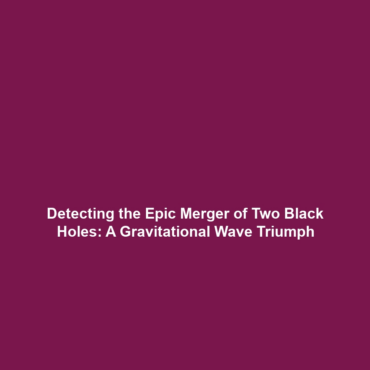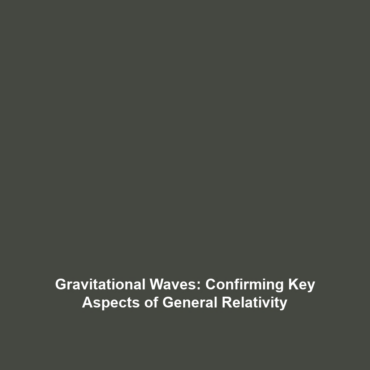The Merger of Two Black Holes and How It Was Detected
The merger of two black holes is a groundbreaking event in astrophysics, marking a significant advancement in our understanding of gravitational waves. Detected for the first time in 2015 by the LIGO (Laser Interferometer Gravitational-Wave Observatory) facilities, this epic cosmic collision opened a new window into the universe’s most mysterious phenomena. As gravitational waves ripple through space-time, they carry vital information about these catastrophic events, fundamentally reshaping our comprehension of black holes and the fabric of our universe.
Key Concepts of Black Hole Mergers
Understanding the merger of two black holes necessitates a grasp of several key concepts related to gravitational waves:
Gravitational Waves
Gravitational waves are ripples in space-time caused by the acceleration of massive objects. When two black holes spiral towards one another and merge, they emit energy in the form of gravitational waves, which are detectable on Earth.
Detection Mechanism
The detection process involves sensitive instruments like LIGO, which measure minute changes in the distance between suspended mirrors caused by passing gravitational waves. Such precision is crucial for identifying events occurring billions of light-years away.
Applications and Real-World Uses
The merger of two black holes provides profound insights into astrophysics and cosmology, leading to several significant applications:
- Astrophysical Research: Studying gravitational waves enables researchers to investigate the properties of black holes, including their masses and spins.
- Cosmological Measurements: Gravitational wave signals assist in measuring the expansion of the universe, contributing to our understanding of dark energy.
- Educational Tools: The discoveries from black hole mergers serve as real-world examples in educational settings, enhancing the teaching of theoretical physics and cosmology.
Current Challenges in Understanding Black Hole Mergers
Despite significant progress, several challenges remain in studying the merger of two black holes and their detection:
- Limited Sensitivity: Advancements in detection sensitivity are necessary to observe more distant or less energetic mergers.
- Data Interpretation: The analysis of detected gravitational wave signals requires complex algorithms and models, which can be a limitation in accurately interpreting data.
- Noise Interference: Disturbances from earthly vibrations and environmental noise can complicate the detection of gravitational waves.
Future Research and Innovations
Future research related to the merger of two black holes promises exciting innovations:
- Advanced Detectors: New-generation instruments, such as the upcoming LIGO-Australia and space-based detectors like LISA (Laser Interferometer Space Antenna), aim to improve detection capabilities.
- Multi-Messenger Astronomy: Combining gravitational wave observations with electromagnetic observations (like gamma rays) to provide a holistic view of cosmic events.
- Artificial Intelligence: The application of AI in analyzing large sets of data generated from gravitational wave detections can lead to quicker and more precise discoveries.
Conclusion
The merger of two black holes, detected through gravitational waves, significantly impacts our understanding of the universe. These cosmic events not only enhance our knowledge of black holes and their dynamics but also open new avenues for research and technology. As we move forward, collaborating on advancements in detection methods and interpreting the resulting data will be crucial.
For more information on gravitational waves and black holes, explore our other articles on black hole astrophysics and gravitational wave technology.

